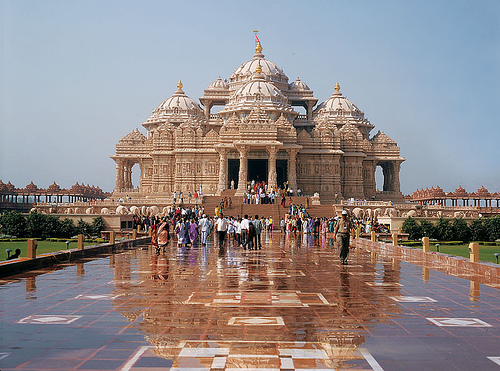
Hindu Mandir(Temple) Rituals - Spiritual Healing
Since ancient times the mandir(temple) has been center of faith and worship of Hindus. Through the ages it has evolved from its primary forms of mountains, caves and yagna altars into awesome and beautiful edifices. For millenia the mandir has been the bastion of Hindu faith and culture.
The rishis of India prescribed specific rules for its construction, with each step having a meaning and every component a function. Since God pervades the universe the mandir is a symbol of the universe. Its shapes and sizes have been so prescribed that they are in harmony with nature and the universe.
The rishis also considered the mandir as the divine body of God. The foundation stone symbolizes his feet, Jagati his thigh, Sthambhs (pillars) his knees, Garbhagruh (inner sanctum) his stomach, Sinhasan (throne) is heart, murti represents his soul, Shikhars (pinnacles) his shoulders, Shuknas (lion) his nose, Gavakshas (windows) his ears, Amalak or Amalsaro (stone ring) his neck, Kalash (golden pot) his head and Dhaja (flag) his hair.
The Murti is the focal point of the mandir (temple). Once the Satpurush invokes the presence of the divine in the murti, the mandir becomes spiritually vibrant. It becomes a center of worship, prayer and peace. The ritual of Pranam, Darshan, Arti, dhyan, chanting, mantras, offering flowers, and other engage a person’s body, senses, mind and heart with the Divine, thus cleansing him or her of bad karmas and imbuing divinity. A restless and wavering mind becomes calm and stable in the mandir.
Some believe Hindu rituals are repetitive, monotonous and incomprehensible. But the apparently small acts of devotion culminate in awakening the inner thoughts and pure Bhav (emotions) for the Divine – the sublime state of God-realization.
The living satpurush of guru’s perfect life and practice of rituals inspire and motivate the disciplines in their spiritual Sadhans. Through the guru’s profound bhakti for God and celebration of traditions the devout, too, follow and practice with full faith, regardless of the over whelming influences of materialism and rationality.
The theme of Mandir Rituals with the faith and confidence that it will further inspire and consolidate the ancient, living tradition of Santan Dharama in the lives of the Hindu Diaspora. The faithful practice of these Pranam, Arti, dhyan, chanting, mantras etc, rituals has blessed countless with sanctity, peace and divine joy